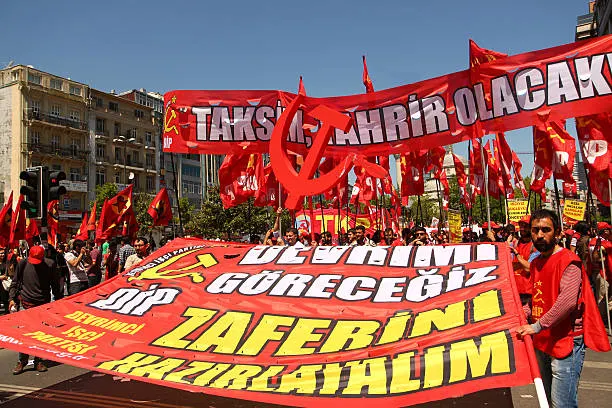May Day | History, Significance
May Day
 |
| People are celebrating the international working day on May 1 in Taksim Square, Istanbul."(Getty) |
May Day, also called International Workers' Day, is observed as a public holiday on May 1st in numerous countries worldwide. This day is dedicated to honoring workers and the labor movement. Its origins can be traced back to the late 1800s when it was established to commemorate the Haymarket affair in Chicago, where several workers were killed by the police while protesting for an eight-hour workday.
The celebration of May Day varies depending on the country and culture. In some areas, it is a day of political demonstrations and rallies, while in others, it is a time for festivities, including maypole dances, traditional food and beverages, and other enjoyable activities.
In certain countries, May Day is also associated with the start of spring and linked with ancient pagan festivals such as Beltane. It is also regarded as a public holiday in several nations, including Cuba, China, and Russia.
May Day History
May Day, also referred to as International Workers' Day, originated from the labor movement in the late 1800s. It can be traced back to the United States, where laborers were fighting for better working conditions, equitable wages, and an eight-hour workday.

People in front of the Norwegian Parliament building on the international Labour Day, on May 1. Oslo, Norway.(Getty)
On May 1st, 1886, thousands of workers across the country went on strike to demand these reforms. The strike was particularly significant in Chicago, where Haymarket Square became a gathering point for workers to protest. Unfortunately, the event turned violent when a bomb was hurled at police officers, resulting in the death of both officers and protesters. This event became known as the Haymarket affair, which marked a pivotal moment in the labor movement and led to the establishment of May Day as a day to honor workers' struggles and achievements.
Over the following years, the celebration of May Day spread to other nations, becoming a symbol of international labor rights and workers' solidarity. Russia was the first country to observe May Day as a public holiday in 1891, and it was eventually adopted by other communist and socialist countries. Today, May Day is still observed differently worldwide, with some nations marking it as a day of political demonstrations and protests while others celebrate with festivities and joy.
Why May Day is celebrated?
May Day, also referred to as International Workers' Day, is an annual celebration that aims to recognize and honor the contributions and accomplishments of workers globally. Its roots can be traced back to the labor movement in the late 1800s, where laborers advocated for better working conditions, fair wages, and an eight-hour workday.
Additionally, May Day commemorates the Haymarket affair that occurred in Chicago on May 1st, 1886, where workers rallied for these same demands. The demonstration became violent, causing the deaths of numerous police officers and protesters. This event was a turning point in the labor movement and led to the establishment of May Day as a day to honor workers' struggles and achievements.
May Day is celebrated differently worldwide, with some countries observing it as a day of political rallies and protests, while others celebrate with festivities, traditional food, and drinks. Moreover, in some regions, May Day is associated with the arrival of spring and is tied to ancient pagan festivals like Beltane. In conclusion, May Day is dedicated to showing appreciation for workers' hard work and contributions worldwide.
What is the story of May Day?
May Day, also referred to as International Workers' Day, has its origins in the late 19th-century labor movement. The movement emerged in the United States, where workers were seeking better working conditions, an eight-hour workday, and fair wages.

Celebrating International Labor Day on 1st May with hand holding wrench on gear wheels background showing the right of labor(Getty)
On May 1st, 1886, workers across the United States went on strike to demand these improvements. The strike was particularly significant in Chicago, where thousands of workers gathered in Haymarket Square to protest. However, the event turned violent after a bomb was thrown at the police, killing several officers and protesters. The Haymarket affair became a crucial turning point in the labor movement and resulted in May Day being established as a day to honor the struggles and accomplishments of workers.
In the subsequent years, May Day celebrations spread to other countries, becoming a symbol of workers' solidarity and international labor rights. Russia first observed May Day as a public holiday in 1891, and other socialist and communist countries subsequently adopted it. In some regions, May Day is a day of political demonstrations and protests, while in others, it is a day of festivities and celebration.
Overall, May Day is a day to recognize and value workers' contributions and hard work worldwide. It serves as a reminder of the importance of workers' rights and the ongoing fight to establish fair and just working conditions.
Who first celebrated May Day?
May Day was established as a public holiday in Russia in 1891, but its roots as a holiday dedicated to workers can be traced back to the late 19th century in the United States. During this time, workers were protesting for better working conditions, equitable wages, and an eight-hour workday. The celebration of May Day then spread to other nations, becoming a symbol of workers' solidarity and international labor rights.
Significance of May Day
May Day, or International Workers' Day, holds great significance as a day to recognize and appreciate the contributions and struggles of workers worldwide. It serves as a reminder of the importance of workers' rights and the ongoing struggle to secure fair and just working conditions.
The roots of May Day lie in the late 19th-century labor movement when workers were advocating for better working conditions, equitable wages, and an eight-hour workday. On May 1st, 1886, workers across the United States went on strike to demand these improvements, which turned violent in Chicago's Haymarket Square, leading to the establishment of May Day as a day to commemorate the struggles and achievements of workers.
May Day is celebrated differently in various parts of the world, with some countries marking it as a day of political demonstrations and protests while others celebrate it with festivities and traditional food and drinks. May Day is also associated with the start of spring and is linked with ancient pagan festivals such as Beltane.
In summary, May Day is a day to honor and appreciate workers' contributions and hard work worldwide, reminding us of the importance of workers' rights and the ongoing struggle to secure fair and just working conditions.




